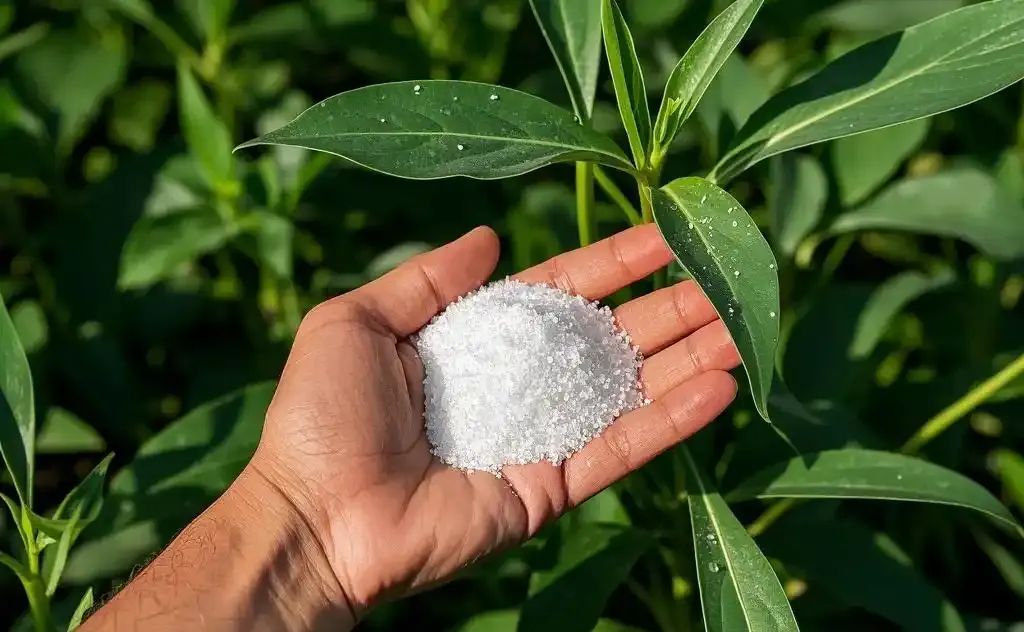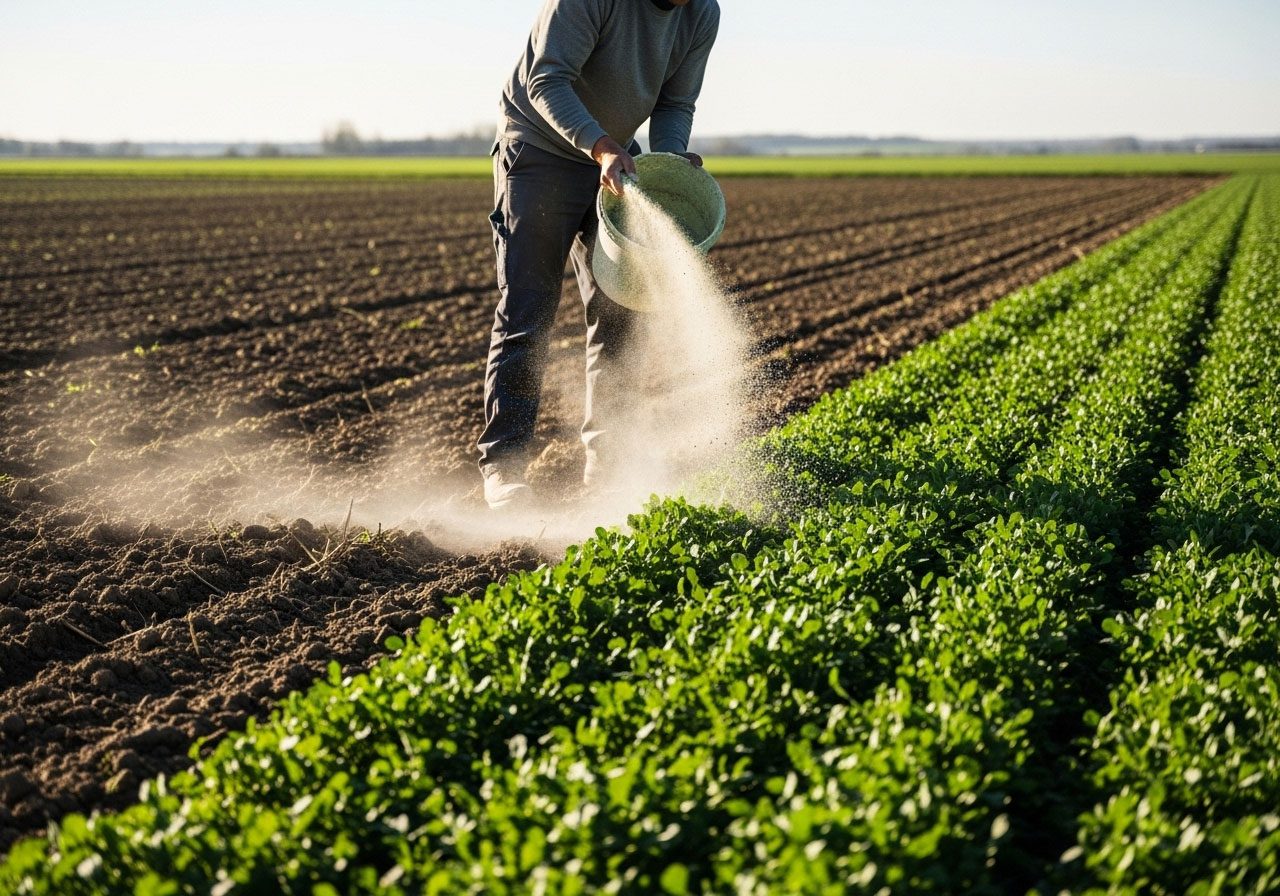Why Plants Need Nitrogen to Grow
One of the most important nutrients for plants to grow well is nitrogen. Plants need chlorophyll to do photosynthesis, which is how they turn sunlight into energy. Plants can’t make the proteins and enzymes they need for cell growth and metabolism if they don’t get enough nitrogen.
One of the most obvious effects of nitrogen is that it helps plants grow thick, green leaves and strong stems. Plants that don’t get enough nitrogen often have pale yellow leaves, weak stems, and slow growth. In crops like corn, lettuce, spinach, and other leafy vegetables, nitrogen has a direct effect on both yield and quality. Now, let’s talk details about nitrogen.
Nutritional Function
- Nitrogen is the main constituent element of proteins:In plant growth, proteins help the cells in division and growth, and a new cell cannot be formed without the proteins, which contain an average of 16%-18% nitrogen. If we don’t have nitrogen, then proteins cannot exist, so there will be no life.
- Nucleic acids and nucleoproteins both have nitrogen in them. Nucleic acids are the basic building blocks of plant growth, development, and life processes. They are made up of 15% to 16% nitrogen.
- Nitrogen is a part of many enzymes, which are biological catalysts that help biochemical reactions and metabolic processes happen in plants. Proteins make up most of enzymes, and the biological catalytic system controls the speed and direction of many biochemical reactions in plants. In most metabolic processes, biochemical reactions need one or more specific enzymes to work. Metabolic processes can’t go smoothly without the right enzymes.
- Nitrogen is a part of chlorophyll, which is the part of plant leaves that makes “food” by using sunlight, carbon dioxide from the air, and moisture from the soil. The amount of chlorophyll directly affects how fast photosynthesis happens and how photosynthetic products are made. When green crops don’t get enough nitrogen, the chlorophyll levels drop, the leaves turn yellow, the photosynthetic intensity drops, and the amount of photosynthetic products drops, which means that the crop yields go down a lot. So, it’s impossible for green plants to grow and develop without nitrogen.
- Nitrogen is a component of certain vitamins such as Vitamin B₁, Vitamin B₂, Vitamin B₁₂, and alkaloids (nicotine, theophylline, etc.). These act as coenzyme components and participate in crop metabolism.
- Nitrogen is a component of certain plant hormones, such as auxins and cytokinins, which contain nitrogen.
- Nitrogen improves the nutritional value of crops, particularly by increasing protein content in seeds and enhancing the nutritional quality of food.
Chlorosis
Nitrogen deficiency symptoms in crops
One of the most obvious signs that crops are lacking nitrogen is that the older leaves start to turn yellow at the tips and move up toward the younger leaves. Not having enough ammonia also lowers the quality of the product by lowering the amount of protein, essential amino acids, alkaloids, and vitamins. Overall, plant growth is slowed down, and the effects are stronger on the parts of the plant that are above ground than on the parts that are below ground. The leaves look grayish-green or yellow, are narrow and small, grow slowly, and there are fewer of them. In very bad cases, the lower mature leaves turn yellow, dry out, and die. The stems get shorter, thinner, and woodier, and there are fewer branches. Roots are stopped from growing and become thin and short. The development of flowers and fruit is delayed, which leads to grains that aren’t fully developed. In bad cases, fruit may fall off, plants may age and ripen too quickly, seeds may be small, the thousand-grain weight may be low, and the yield may be lower. The following table lists nitrogen deficiency symptoms in several crops:
| Crops | Nitrogen deficiency symptoms |
|---|---|
| Cabbage, kale | Plants that don’t get enough nitrogen early on have small, thin leaves that turn yellow and grow slowly. Mid-to-late nitrogen deficiency keeps heads from developing properly, delays heading, raises leaf fiber content, and lowers quality. |
| Eggplant | Plants are small and have thin, pale green leaves. When they bear fruit, a lack of nitrogen causes a lot of flowers and fruit to fall off. |
| Carrot | The leaves are narrow and thin, and they are turning yellow. Stems are weak and thin. Roots are small, not fully grown, and mostly made of wood. The pungency got stronger. |
| Tomato | Plants don’t grow much, and they stay short. The leaves are light green or yellowish, small and thin, and the veins change from green to deep purple. The stems turn deep yellow, hard, and fibrous. Flower buds turn yellow and fall off easily. The fruits are small and not many, and they feel like wood. |
| Cucumber | Plants that don’t get enough nitrogen early on don’t grow as big, so they stay small and their leaves slowly turn yellow or yellowish-green. The stems get thinner, harder, and more fibrous. The fruits turn pale, with the end that has petals looking light yellow to brown. |
Types of Nitrogen Fertilizer for Plants
Organic Nitrogen Fertilizers
Natural sources give organic nitrogen fertilizers their name, and they make the soil healthier over time. Some common examples are:
- Compost and manure add organic matter and slowly release nitrogen.
- Blood meal is an organic nitrogen source that works quickly.
- Fish emulsion gives plants and flowers quick nitrogen in liquid form.
- Alfalfa meal and soybean meal are both plant-based options for organic gardening.
Here’s the best high-nitrogen fertilizer comparison chart
| Product | N-P-K | Release | Best for | Typical use-rate |
|---|---|---|---|---|
| Blood meal | 12-0-0 | 2–6 w | Fast green-up | 1–3 Tbsp/ft² |
| Feather meal | 12-0-0 | 3–6 mo | Long-season veg | 5 lb/100 ft² |
| Fish hydrolysate | 5-1-1 | 1–2 w | Foliar & hydroponics | 10 mL/L |
| Alfalfa meal | 2.5-0.5-2.5 | 1–3 mo | Balanced feed + triacontanol | 10 lb/100 ft² |
| Our Certified 5-3-2 granular | 9-2-2 | 6–8 w | All-purpose gardens | 2.5 lb/100 ft² |
Synthetic Nitrogen Fertilizers
Unlike organic fertilizer, synthetic fertilizers give plants concentrated nitrogen that they can take up quickly:
- Urea is one of the most common fertilizers and has 46% nitrogen.
- Ammonium nitrate is a fast-release source of nitrogen, but it is less common because it can be dangerous.
- Ammonium sulfate is good for alkaline soils because it gives them nitrogen and sulfur.
Liquid vs. Granular Fertilizers
- Liquid nitrogen fertilizers work quickly and are easy to use by watering or spraying the leaves.
- Granular fertilizers last longer and are good for feeding plants slowly and steadily.
Slow-Release vs. Quick-Release
- Slow-release Nitrogen gives plants nutrients over time, which cuts down on leaching and the chance of over-fertilizing.
- Quick release Nitrogen works quickly, but you have to be careful when using it so that it doesn’t burn plants.
Best Nitrogen Fertilizer for Different Plants
Vegetables
Nitrogen fertilizer is very important for leafy greens, like lettuce, spinach, and kale, they can grow fast and healthy with the help of nitrogen. Crops such as corn and tomatoes also can benefit from nitrogen during active growth stages.
Plants & Flowers
Nitrogen helps plants grow healthy by making their leaves bright and colorful. But, please be careful not to fertilize with too much nitrogen, it will make flowers less likely to bloom. So you’d better keep the nitrogen fertilizer in balance.
Lawns
The main nutrient for lawns is nitrogen. Regular use keeps the grass green, thick, and able to handle stress. If grass needs steady growth, you’d better choose the slow-release formulations.
Fruit Trees
During the early growth stages, nitrogen can help fruit trees to grow their leaves and make their branches grow strong. But too much nitrogen will make the fruit trees only grow leaves and will take longer to grow fruit. So it’s best to use small amounts.
How to Use Nitrogen Fertilizer the Right Way
Test the Soil First
It’s best to test the soil before using nitrogen fertilizer. This makes sure you give the right amount without throwing off the balance of nutrients.
How to Apply
- Broadcasting means spreading fertilizer evenly over the surface of the soil.
- Side-dressing is putting fertilizer near the base of plants while they are growing.
- Foliar feeding is when you spray liquid nitrogen directly on leaves so they can soak it up quickly.
Guidelines for Frequency and Dosage
How often you apply it depends on the type of crop and fertilizer. During the growing season, lawns may need to be fed several times, and vegetables may need nitrogen when they are planted and again when they are growing quickly.
Young vs. Mature Plants
Young plants need a moderate amount of nitrogen to grow roots and leaves. Mature plants, on the other hand, may need different amounts depending on whether they are grown for leaves, flowers, or fruits.
Common Mistakes In using Nitrogen
- Over Fertilization: As mentioned before, too much nitrogen will burn your plants’ leaves, make them grow too fast, and also make them weak.
- Wrong timing: If you feed your plants nitrogen at the wrong time, it can stop plants from flowering and fruiting.
- Soil Health: If you’re not paying attention to soil health, fertilizers cannot fix soil that is too acidic or has a bad structure.
FAQs About Nitrogen Fertilizer
1. Can too much nitrogen stop tomatoes from fruiting?
Yes. Excess nitrate pushes vegetative growth and delays flowering; keep petiole sap <1,200 ppm after first fruit set.
2. Is urea organic?
Only if it’s certified “OMRI-listed urea,” which is rare. Standard urea is synthetic.
3. How often to feed indoor plants?
Half-strength fish hydrolysate every 14 days; monthly plain water flush.
4. Blood meal vs. feather meal—smell?
Blood meal smells metallic for 1–2 days; feather meal is odorless once watered in.
5. Will high-nitrogen organic fertilizer attract pests?
Properly incorporated or irrigated—no. Surface piles of blood meal can attract raccoons; cover with ½ inch of soil.
6. Can too much nitrogen harm plants?
Yes, excess nitrogen can cause leaf burn, weak stems, and delayed flowering or fruiting.
7. How long does nitrogen fertilizer take to work?
Liquid fertilizers may show results within days, while granular or organic fertilizers release nutrients more slowly.
8. Is nitrogen fertilizer safe for organic gardening?
Organic nitrogen sources such as compost, manure, and fish emulsion are safe and commonly used in organic farming.
Conclusion
Nitrogen is very important for plants, it can help plants grow strong, green, and productive. After reading our article, you can understand the nitrogen fertilizer types and when and how to fertilize the plants, and the importance of keeping soil balance, farmers and gardenersers can maximize plant health and yield.
The most important thing is that how to use nitrogen wisely, no matter if you use organic or synthetic fertilizers. This will help plants grow and keep the soil healthy for a long time.





